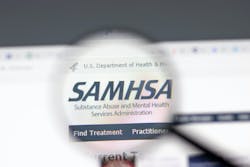SAMHSA Reports on Progress in Value-Based Payment for SUD Services
As more states begin to experiment with value-based payment (VBP) for substance use disorder (SUD) treatment and recovery services, the federal Substance Abuse and Mental Health Services Administration (SAMHSA) is seeking to capture early implementation practices and experiences in order to highlight opportunities for improvement and broader adoption.
In a new report, SAMHSA notes that due to the magnitude of substance use disorders (SUDs) in the United States, there has been a growing movement toward using VBP for SUD treatment and recovery services.
This report explores the use of VBP for SUD services, summarizing evidence for each state’s progress toward implementing VBP for SUD services through a review of publicly available resources and documentation. The report also discusses the major challenges to adopting VBP for SUD services and offers potential solutions to help overcome them.
SAMHSA found that states are taking various approaches to implementing VBP for SUD treatment and recovery services. Some states are proposing and passing laws to require a portion of payments for SUD services to be tied to value. Other states are using Section 1115 Demonstration Waivers or other Medicaid waiver authority to set target VBP goals across their Medicaid managed care contracts.
There are other funding streams furnished through state and federal grants and programs, such as the Substance Use Disorder Prevention that Promotes Opioid Recovery and Treatment for Patients and Communities (SUPPORT) Act Section 1003 demonstration that enable states to use VBPs to expand capacity and increase the quality of SUD care. Some private providers, such as Wayspring and Eleanor Health, are partnering with managed care organizations to deliver value-based SUD care regionally.
As of March 2023, eight states have well-developed and ongoing VBP initiatives for SUD services, while 20 states have low or no evidence of VBP for SUD treatment and recovery services and 22 states have medium evidence.
SAMHSA notes that linking payment to outcomes is a challenge for substance use disorders, just as it is for other chronic diseases that require long-term care. Other challenges identified to the further development and implementation of VBP for SUD treatment and recovery services include the fragmentation between physical and behavioral health care; workforce and training issues; difficulties with measuring the quality of SUD treatment; limitations in data infrastructure and sharing capacity; and underinvestment in SUD treatment and recovery services.
The report says that potential solutions to these challenges include supporting care coordination, incentivizing provider training in SUD treatment, developing consensus on meaningful patient-centered outcome measures, and improving data and record-keeping infrastructures.
“Sustainable, long-term financial and stakeholder investment is needed to support these solutions,” the report says. “With such support, VBP models have promising potential to improve the quality and cost-effectiveness of SUD treatment and recovery services nationwide.”


